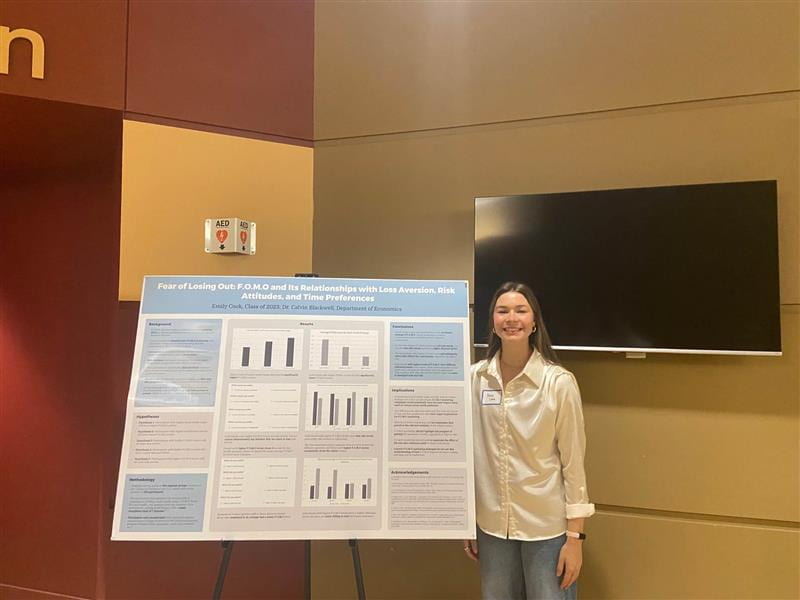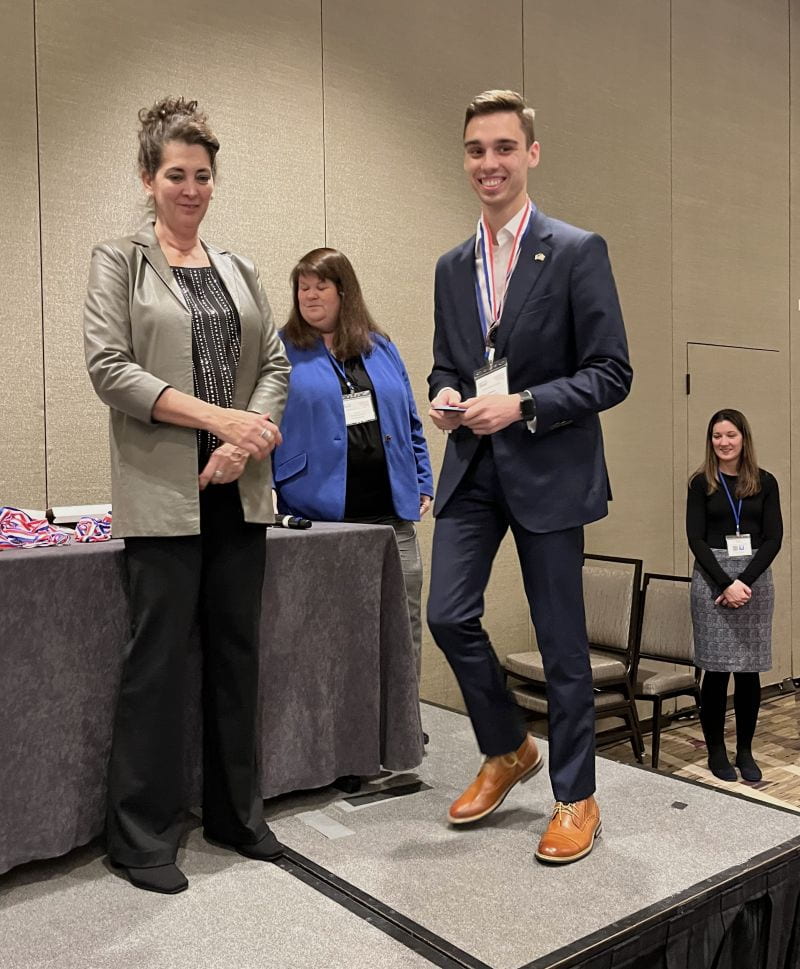The School of Business is thrilled to spotlight outstanding business students who recently participated in EXPO 2023 and walked away with top honors.
These students not only demonstrated a deep understanding of their field, but also showcased their ability to conduct rigorous research and communicate their findings effectively.
Congratulations to this year’s award recipients from the School of Business:
Oral Presentation Alumni Association Award, Third Place
Andrea Kimpson, economics and international studies double major, Honors College International Scholar and Public Choice Associate
Project: “An Evaluation of the Uniform Partition of Heirs’ Property Act”
Faculty Mentor: Peter Calcagno, professor of economics and director of the Center for Public Choice and Market Process
More about Andrea’s research
Legal and illegal forms of discrimination contribute to long-standing wealth disparities for African Americans. One contributor to this disparity can be found in land loss due to the partition sale of heir’s property, property passed to family members by inheritance without a will or estate planning strategy. A lack of clear legal title leaves heirs vulnerable to partition sales where land is divided and split, often without full consent from all heirs. The Uniform Partition of Heirs’ Property Act (UPHPA) emerged in 2010 to address this issue by giving legal protection to individual heirs’ property owners during a sale. The UPHPA provides structure for the independent fair market value appraisal of property and creates opportunities for heirs’ to contest the appraisal and sale. This paper aims to evaluate the efficacy of the UPHPA in increasing wealth for African Americans in the south and posits that it was successful. A difference-in-difference framework will be used to compare the changes in wealth over time for African Americans in states that enacted the law using data from the Decennial Census, the American Community Survey and the House Price Index from the Federal Housing Finance Agency. States will be grouped into cohorts by year of enactment with a pre-treatment period beginning in 2000 and a post-intervention period ending in 2020. From this analysis, it will be possible to draw conclusions about the effects of formalizing property ownership among marginalized groups using lenses of equity, accuracy, and efficiency.
School of Business Dean’s Choice Alumni Association Award
Emily Cook, economics major and marketing and political science double minor in the Honors College
Project: “F.O.M.O and Its Relationships with Mindfulness, Social Media Usage, Loss Aversion, Risk Attitudes, and Time Preferences”
Faculty Mentor: Calvin Blackwell, professor of economics
More about Emily’s research
We surveyed 545 U.S. adults about their feelings of F.O.M.O (fear of missing out), mindfulness habits, social media usage, loss aversion, and discount rate. We find that individuals who have higher levels of social media usage are significantly more likely to report higher levels of F.O.M.O, as measured by the Fear of Missing Out Scale (Przybylski et al., 2013). Those with higher levels of F.O.M.O also indicate different relationships with loss aversion and discount rate than those with lower levels of F.O.M.O. Primarily, higher levels of F.O.M.O led to lower levels of loss aversion and less present bias than hypothesized. These lower levels of loss aversion and lack of present bias were significantly different than the levels seen in individuals with lower levels of F.O.M.O. The relationship between F.O.M.O and mindfulness was as expected: higher levels of mindfulness, measured by the Five Facet Mindfulness Questionnaire, led to lower reported F.O.M.O levels. This suggests that currently utilized F.O.M.O marketing tools may not be producing the anticipated and desired results from consumers.
Best Poster Awards
First Runner-Up
Isaiah Kahn, business administration major with a concentration in entrepreneurship in the Honors College
Project: “Sentiment Surrounding ChatGPT”
Faculty Mentor: Lancie Affonso ’96, Honors College faculty fellow, director of the E-LLC and senior instructor in computer science, management and marketing
More about Isaiah’s research
ChatGPT is a powerful tool that is changing the way people work. Artificial intelligence is closing in on revolutionizing how most industries operate, and people are reacting differently to this issue. The goal of this project is to quantify sentiment, display opinions and set a foundation for how to approach ChatGPT’s integration into society. Data will be collected using code that searches Twitter for tweets containing the term ChatGPT. Data will be consolidated and organized to allow insights to be made using business intelligence tools. The desired result will accurately map out social-media based sentiment directed towards ChatGPT in a way that clearly explains how people feel about it. Producing the most used words within segmented opinions will add context and help illustrate the “why’s” behind people’s views. We are currently at the beginning of a new technological era, and it is increasingly important to understand and consider emotions and attitudes among the general population.
Second Runner-Up
 Rex Bingham, supply chain management and international business double major in the Honors College
Rex Bingham, supply chain management and international business double major in the Honors College
Project: “Communication Technology in the Food Supply Chain”
Faculty Mentor: Rafael Teixeira, assistant professor of supply chain and operations management
More about Rex’s research
This paper analyzes the communication technologies that are used between the tiers of different industries’ food supply chains. These technologies are often used for communication between companies, information-sharing, visibility into the supply chain levels, accountability, and safety for the consumers. The different food supply chains that are analyzed in this paper are general meat, beef, pork, fish, dairy, grain, and vegetable. This paper will outline some of the technology that is currently being used in each of these supply chains, in addition to technologies that will likely be used in the near future. Some of the most prevalent technologies that will be discussed in this paper, which are therefore present in the aforementioned supply chains, are blockchain, IoT devices, cell phone/mobile devices, equations and math modeling, industry 4.0 technology, RFID, smart packaging technology, cloud-based technology, electronic traceability systems (ET), artificial intelligence, and big data. The method of research for this paper up to the current time has been a literature review of the topic, and this preliminary research suggests that the objective of this paper is to synthesize and reveal new connections between the tiers of the food supply chain and technology used amidst them. Further research in coming months will utilize interviews of supply chain professionals.
Third Runner-Up
Sebastiano Ronchi, supply chain management and finance double major
Project: “The Information Source Terrain: Mapping Relevancy in Supply Chain Media”
Faculty Mentor: Rafael Teixeira, assistant professor of supply chain and operations management
More about Sebastiano’s research
Today’s news landscape relies on Internet capabilities to provide instantaneous news and information to professionals and businesses alike. Within the area of supply chain, a whole category of publications exists dedicated to reporting on current supply chain issues on a local and global scale. This subset of digital news is responsible for producing hundreds of articles entering cyberspace every day, sourced from accredited and informal sources alike. While the abundance of digitalized news provides the opportunity for supply chain professionals to access a wide variety of authors and articles like never before, it subsequently creates a dilemma of choice, where the validity of the content presented to readers is left to the judgment of the reader’s impressions of the source rather than its true credibility. With publications not producing equal levels of quality among their content, this research attempts to quantitatively measure biases and quality among 41 supply chain publications actively reporting on the Internet, of which 18 sources the authors believe provide quality, current news. By analyzing the contents of 500 articles sourced from the 18 publications against nine recurring themes, results show varied levels of bias towards topics among widely read publications.
More than 250 student projects were presented, nearly a dozen coming from business students.








